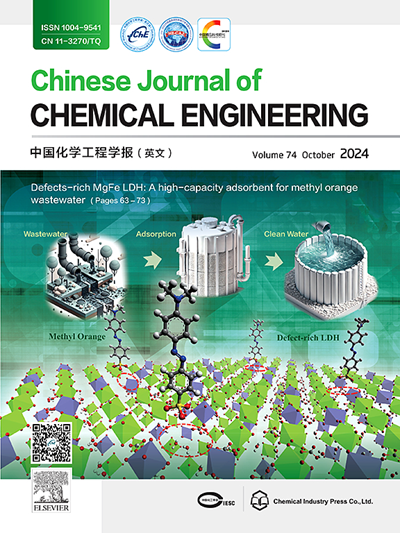Comprehensive utilization of Titanium-bearing Blast Furnace Slag by H2SO4 Roasting and Stepwise Precipitation
IF 3.7
3区 工程技术
Q2 ENGINEERING, CHEMICAL
引用次数: 0
Abstract
Titanium-bearing blast furnace slag (Ti-BFS) is an industrial solid waste rich in titanium, magnesium and aluminum. However, it is difficult to utilize Ti, Mg and Al from Ti-BFS for the strong stability and poor reaction activity of Ti-BFS. A comprehensive utilization route of Ti, Mg and Al from Ti-BFS was proposed. Ti-BFS was firstly roasted with H2SO4 to realizes the conversion of Ti, Mg and Al to their corresponding sulphates. The sulphates were leached by dilute H2SO4 solution to extraction Ti, Mg and Al from roasted Ti-BFS. The roasting conditions were optimized as follows, sulfuric acid concentration of 85%(mass), temperature of 200 °C, acid-slag ratio of 5.5, particle size of Ti-BFS <75 μm, and reaction time of 1 h. The extraction rates of titanium, aluminum, and magnesium reached 82.42%, 88.78% and 90.53%, respectively. The leachate was hydrolyzed at 102 °C for 5 h with a titanium hydrolysis ratio of 96%. After filtration and calcination, TiO2 with a purity of 97 %(mass) was obtained. Al in the leachate was converted to NH4Al(SO4)2·12H2O by the neutralization of ammonia water at pH = 4.5. Al2O3 was obtained by the calcination of NH4Al(SO4)2·12H2O. The residual solution can be used to prepare products of magnesium sulfate. In the proposed process, Ti, Mg and Al were extracted from Ti-BFS and utilized comprehensively to prepare valuable products. The leaching behavior of roasted Ti-BFS with water was also studied. It followed the unreacted shrinking core model. The apparent activation energy was 26.07 kJ·mol−1 . This research not only provides a viable method for recovering valuable metals in Ti-BFS, but also provides a strategy to comprehensive utilize the valuable elements in Ti-BFS.

硫酸焙烧分步沉淀法综合利用含钛高炉渣
含钛高炉渣(Ti-BFS)是一种富含钛、镁、铝的工业固体废物。然而,由于Ti- bfs稳定性强,反应活性差,很难利用Ti、Mg和Al。提出了Ti- bfs中Ti、Mg、Al的综合利用路线。首先用H2SO4焙烧Ti- bfs,使Ti、Mg、Al转化为相应的硫酸盐。用稀硫酸溶液浸出焙烧Ti- bfs中的硫酸盐,提取Ti、Mg和Al。优化焙烧条件为:硫酸浓度为85%(质量),温度为200℃,酸渣比为5.5,Ti-BFS粒度为75 μm,反应时间为1 h,钛、铝和镁的提取率分别达到82.42%、88.78%和90.53%。浸出液在102℃水解5 h,钛水解率为96%。经过过滤和煅烧,得到了纯度为97%(质量)的TiO2。通过pH = 4.5的氨水中和,渗滤液中的Al转化为NH4Al(SO4)2·12H2O。用NH4Al(SO4)2·12H2O煅烧制得Al2O3。剩余溶液可用于制备硫酸镁产品。在该工艺中,从Ti- bfs中提取Ti、Mg和Al,并进行综合利用,制备出有价值的产品。还研究了焙烧后的Ti-BFS与水的浸出行为。它遵循未反应收缩核模型。表观活化能为26.07 kJ·mol−1。本研究不仅为Ti-BFS中有价金属的回收提供了可行的方法,而且为Ti-BFS中有价元素的综合利用提供了策略。
本文章由计算机程序翻译,如有差异,请以英文原文为准。
求助全文
约1分钟内获得全文
求助全文
来源期刊

Chinese Journal of Chemical Engineering
工程技术-工程:化工
CiteScore
6.60
自引率
5.30%
发文量
4309
审稿时长
31 days
期刊介绍:
The Chinese Journal of Chemical Engineering (Monthly, started in 1982) is the official journal of the Chemical Industry and Engineering Society of China and published by the Chemical Industry Press Co. Ltd. The aim of the journal is to develop the international exchange of scientific and technical information in the field of chemical engineering. It publishes original research papers that cover the major advancements and achievements in chemical engineering in China as well as some articles from overseas contributors.
The topics of journal include chemical engineering, chemical technology, biochemical engineering, energy and environmental engineering and other relevant fields. Papers are published on the basis of their relevance to theoretical research, practical application or potential uses in the industry as Research Papers, Communications, Reviews and Perspectives. Prominent domestic and overseas chemical experts and scholars have been invited to form an International Advisory Board and the Editorial Committee. It enjoys recognition among Chinese academia and industry as a reliable source of information of what is going on in chemical engineering research, both domestic and abroad.
 求助内容:
求助内容: 应助结果提醒方式:
应助结果提醒方式:


